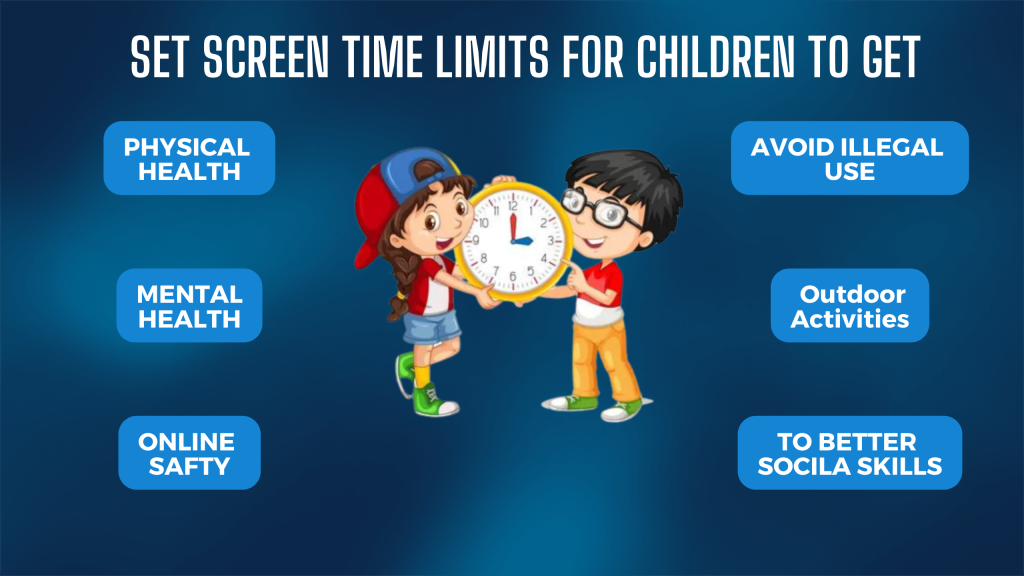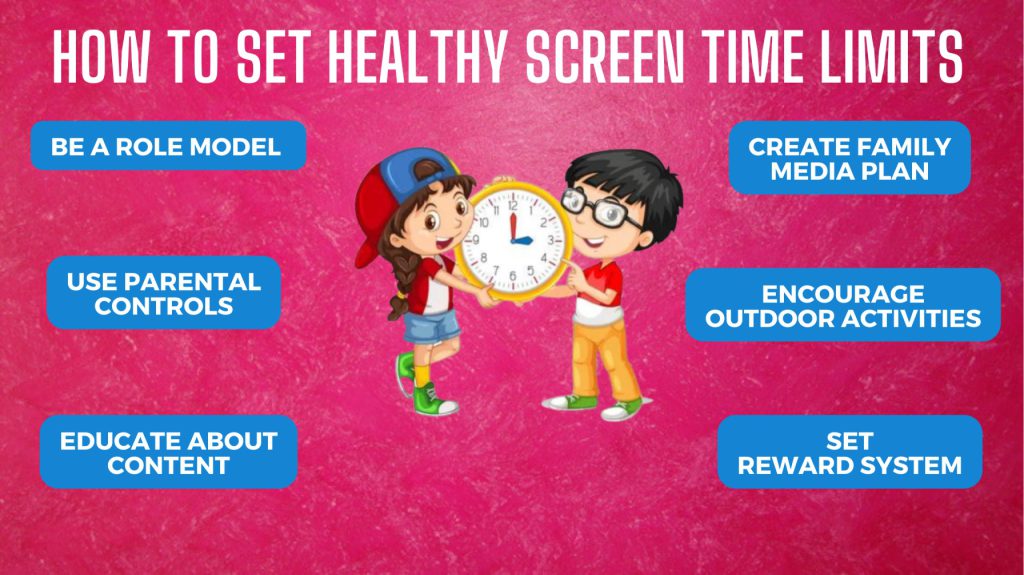In today’s digital age, mobile devices have become an integral part of our daily lives, especially for kids. From educational apps to games and social media, there’s a wealth of content available at our fingertips. While these devices can be valuable tools for learning and entertainment, it’s essential for parents to establish healthy screen time limits to ensure their children’s well-being. In this blog, we’ll explore the importance of setting these limits and provide practical tips to help you strike the right balance.
Why Set Screen Time Limits?
Children’s excessive screen time has been linked to a range of issues, including:

Physical Health :
Prolonged screen time can significantly contribute to a sedentary lifestyle, which, in turn, leads to various health problems, including obesity and posture issues. Sedentary behavior involves extended periods of sitting or lying down with minimal physical activity, and it has become increasingly common due to the widespread use of smartphones, tablets, and computers.
One of the most concerning consequences of excessive screen time is the heightened risk of obesity. A sedentary lifestyle means fewer opportunities for physical activity, which is vital for maintaining a healthy weight. When individuals, especially children and adolescents, spend long hours in front of screens, they tend to be less active, burning fewer calories than they consume. This imbalance can lead to weight gain and ultimately increase the likelihood of obesity.

Furthermore, excessive screen time often coincides with poor posture. Whether individuals are hunched over a smartphone or slouched in front of a computer, prolonged screen use can strain the neck, shoulders, and back. This strain can result in discomfort, musculoskeletal problems, and potentially long-term posture issues if not addressed. Therefore, it is essential to be mindful of screen ergonomics and take regular breaks to stretch and correct posture, helping to mitigate the negative effects of extended screen time on physical health.
Mental Health:
Excessive screen time among children has been linked to a range of mental health issues, raising concerns among parents and experts alike. One significant consequence is sleep disturbances. The blue light emitted by screens can interfere with the body’s natural sleep-wake cycle, making it harder for children to fall asleep and stay asleep. This can lead to irregular sleep patterns and sleep deprivation, which, in turn, can affect mood, cognitive function, and overall mental well-being. Sleep is crucial for a child’s development, and disruptions caused by excessive screen time can have lasting effects on their mental health.
Moreover, excessive screen time has been associated with increased levels of anxiety and depression in children. Prolonged exposure to screens, especially on social media platforms, can lead to social comparison and feelings of inadequacy or loneliness. Additionally, the constant stimulation and digital noise can contribute to heightened stress levels. Children may also experience cyberbullying or encounter disturbing content online, further exacerbating their mental health issues.

In addition to the emotional toll, excessive screen time can lead to decreased academic performance. Spending too much time on screens can reduce the time available for homework, reading, and other educational activities. It can also impair a child’s ability to concentrate and absorb information. As a result, children who spend an excessive amount of time on screens may struggle in school, leading to frustration, lowered self-esteem, and additional mental health challenges. To promote better mental health outcomes, it’s crucial for parents to monitor and manage their children’s screen time effectively, ensuring a balance between digital engagement and other essential aspects of their lives.
Social Skills:
Excessive screen time in children can impede the essential development of social skills and face-to-face interactions, posing significant challenges for their overall growth and well-being. In today’s digital era, kids are often drawn to screens, whether it’s smartphones, tablets, or computers. While technology offers various benefits, it can also hinder the acquisition of vital social abilities, such as effective communication, empathy, and problem-solving.
One key consequence of spending too much time on screens is a reduced opportunity for kids to practice these crucial social skills. Interactions on screens lack the non-verbal cues and nuances found in face-to-face communication, making it challenging for children to learn how to read emotions, engage in meaningful conversations, and develop empathy towards others. These abilities are fundamental for forming healthy relationships, resolving conflicts, and navigating the complexities of social situations. As a result, excessive screen time can hinder children’s capacity to connect with peers and adapt to various social contexts effectively.
Additionally, prolonged screen use can lead to isolation. Children who spend an excessive amount of time in the digital realm may withdraw from real-world social interactions, favoring virtual connections over genuine face-to-face relationships. This isolation can contribute to feelings of loneliness and social detachment, which can have long-term implications for children’s mental and emotional well-being.
To support the healthy development of social skills, parents should actively encourage a balanced approach to screen time. Activities like family outings, playdates with friends, and participation in group activities can provide opportunities for children to enhance their social abilities while still enjoying the benefits of technology in moderation. By striking this balance, children can nurture their social skills and maintain meaningful real-world connections.
Safety:
Ensuring the safety of children online is a top priority for parents in today’s digital age. Unrestricted access to the internet can pose serious risks, including exposure to inappropriate content and online predators, making it crucial for parents to take proactive steps to protect their children.

The internet is a vast and open space, and children can stumble upon inappropriate or harmful content unintentionally. This content can include explicit images, violent videos, or misleading information that may not be suitable for their age. Exposure to such content can have a negative impact on a child’s emotional and psychological development. It’s essential for parents to employ parental control tools and software to filter and block inappropriate websites and content.
Moreover, the internet provides anonymity that can be exploited by online predators. These individuals often disguise themselves as children or trustworthy figures to gain a child’s trust. They may engage in conversations, request personal information, or attempt to arrange in-person meetings. To protect children from online predators, parents should educate them about the potential dangers of online interactions, encourage open communication, and monitor their online activities closely.
In conclusion, safeguarding children from the perils of unrestricted internet access is paramount. By employing parental controls, educating children about online risks, and maintaining an open and supportive dialogue, parents can create a safe online environment that allows children to explore and learn while staying protected from inappropriate content and online predators.
By setting screen time limits, parents can minimize these risks and ensure a more balanced and healthy lifestyle for their children.
How to Set Healthy Screen Time Limits?

Be a role model and Create family media plan
To foster healthy screen time habits in children, it’s crucial to heed the guidance provided by trusted organizations like the American Academy of Pediatrics. These guidelines, which recommend no more than one hour of screen time per day for youngsters between the ages of 2 to 5, and advocate for consistent limits for older children, serve as a valuable compass for parents navigating the digital landscape. They underscore the importance of maintaining a balanced approach to screen time, acknowledging the need for both digital engagement and other essential aspects of a child’s development.
In addition to following established recommendations, parents play a pivotal role in shaping their children’s screen time behavior through leading by example. Children tend to mimic what they see their parents do, and this principle extends to device usage. When parents demonstrate responsible screen time habits, such as setting boundaries and prioritizing real-world interactions over screens, they impart invaluable lessons to their children. By showcasing the importance of a well-rounded lifestyle that includes outdoor activities, reading, and face-to-face conversations, parents can inspire their kids to adopt a healthier approach to screen time.
To further solidify these principles, creating a family media plan can be an effective strategy. Collaborating with children to establish such a plan empowers them to be part of the decision-making process, promoting a sense of ownership and responsibility. The plan should encompass comprehensive guidelines for screen time, including when it’s allowed, the type of content that’s acceptable, and specific device-free zones within the home, such as the dining table or bedrooms. This collaborative approach fosters open communication within the family, encourages mutual understanding, and helps strike a harmonious balance between screen time and other enriching activities in a child’s life.
In essence, promoting healthy screen time habits in children involves a holistic approach that combines expert guidance, parental role modeling, and collaborative family planning. By adhering to recommended guidelines, setting a positive example, and working together to create a family media plan, parents can nurture a balanced and responsible approach to screen time that benefits their children’s overall development.
Use Parental Controls and Encourage Outdoor Activities:
In the quest for fostering healthy screen time habits in children, it’s essential for parents to implement practical strategies that complement established guidelines and their own exemplary behavior. One effective tactic is to establish specific time windows for screen use, aligning it with educational priorities. For instance, reserving screen time for after school or once homework is completed encourages children to develop a routine that places emphasis on their academic and physical well-being. This approach instills the notion that screens are not a primary focus but rather a reward for fulfilling important responsibilities.
Moreover, parental control features offered by various devices and apps provide an additional layer of support for parents. These tools empower parents to set daily time limits on screen usage and to ensure that their children are accessing content suitable for their age and maturity level. By leveraging such controls, parents can strike a balance between granting their children access to technology and safeguarding them from age-inappropriate material, promoting a safer and more constructive digital experience.
In addition to these measures, encouraging outdoor activities and physical play is fundamental in countering excessive screen time. Organizing family outings, sports activities, or even nature hikes not only keeps children engaged in healthy, physical pursuits but also reinforces the value of a well-rounded and active lifestyle. This holistic approach, combining recommended guidelines, positive role modeling, time management, parental controls, and physical engagement, collectively nurtures a balanced and comprehensive development in children while ensuring responsible screen time management in today’s digital age.
Educate About Content:
In today’s digital world, it’s really important for parents to teach their kids how to be smart and safe online. This means talking to them about what’s okay and not okay to do on the internet. Parents can explain how to spot things that are not suitable for them and how to report them if they come across them. It’s like teaching them to be cautious and aware while exploring the digital world.

Parents should also keep an eye on how much time their kids spend on screens. This helps make sure that kids don’t spend too much time on devices and that they still have time for other important things like homework, playing outside, and talking to family and friends face-to-face.
But most importantly, parents should have open conversations with their kids about why screen time limits are in place and the potential problems that can come from spending too much time online. This way, kids understand why these rules are important and can make good choices when using screens. These talks help kids become responsible and safe digital explorers, keeping them both informed and secure in today’s digital world.
Reward System:
Implementing a reward system can be a great strategy for parents to encourage responsible screen time habits in their children. This system involves offering incentives like extra screen time as a reward for completing various tasks and responsibilities. It’s a positive way to motivate kids to prioritize their chores, homework, and other important duties while earning some additional screen time as a treat.
By tying screen time to tasks like completing homework or helping with household chores, parents create a clear connection between responsibilities and screen privileges. This not only instills a sense of responsibility in children but also teaches them valuable time management skills. It reinforces the idea that screen time is a privilege to be earned through completing tasks, helping them develop a balanced approach to both their responsibilities and digital activities.

Parents can customize the reward system to suit their family’s needs and goals. For example, they can set specific tasks and associated screen time rewards, ensuring that the rewards align with the child’s age and interests. This approach empowers parents to strike a healthy balance between screen time and other responsibilities, creating a structured and positive environment for their children to thrive in.
Setting healthy screen time limits for mobile devices is essential for your child’s physical, mental, and social well-being. By following these practical tips and guidelines, you can strike a balance between technology use and other activities, ensuring that your child develops into a well-rounded individual. Remember that the key is moderation and education, so your child can harness the benefits of technology while avoiding its pitfalls.



Leave a Reply